Evidence
|
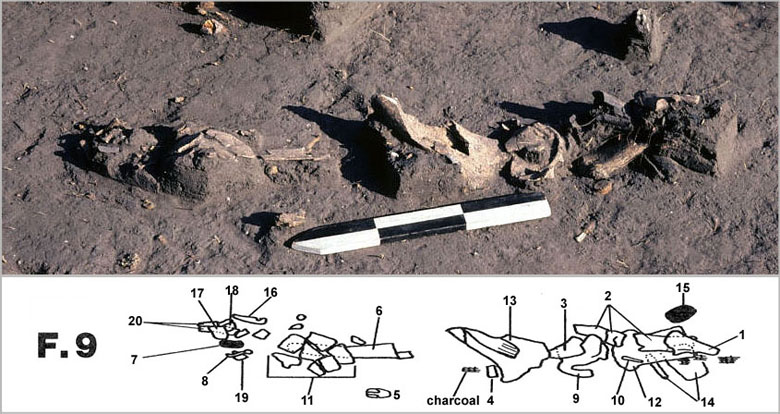
The archeological evidence recovered from the Hinojosa site is quite robust and consists of many
different kinds of data including artifacts, soil samples, notes, drawings, photographs, and so on.
Processing these data – washing, labeling, inventorying, organizing, and preparing for analysis and
long-term curation – took months of work at the CAR laboratory at UTSA. The analysis and reporting
continued intermittently for several more years. Most of the work was done in San Antonio but
certain materials, such as the animal bones and the charred plant remains, were sent to specialists
at Texas A&M and elsewhere for analysis. The results are reported in considerable detail in the
site report. The following brief summaries have links to details from the report.
Features
Three types of archeological features were recognized at the Hinojosa site: rock/charcoal clusters,
bone clusters, and living surfaces.
Two living surfaces were sampled at the site, one beside the 1975 bone bed and one that covered much
of the Wagon Trail Area. A living surface is a thin layer of concentrated debris – artifacts, bones,
snails, etc. – though to represent materials that accumulated on the surface of an active area of the
camp. Among the artifacts were many that were laying flat upon an apparent surface. Cooking and disposal
features occurred within or adjacent to the living surfaces as well as smaller concentrations that seem to
represent particular activities.
Five clusters of rock and/or charcoal were documented and lumped together under the general term
“rock/charcoal cluster.” Three of the five were little more than suggestive clusters that did not
preserve definitive evidence of their original form and function, although they probably resulted from some sort of cooking activity. Fortunately, two features were well-preserved
cooking facilities of contrasting scale.
Feature 5 was a small pit hearth filled with ash and charcoal that measured about 18” across and
6” deep. The feature had evidence that it had been used several times and contained a fire hot enough
to bake and discolor the clay-rich soil around it. There were bone fragments of large and small
mammals and a fish as well as an unidentified charred seed fragment. The pit itself was filled with
ash, suggesting the fire it last contained was allowed to burn itself out and was left undisturbed.
Small pockets of bone and baked clay adjacent to the pit suggest the hearth was cleaned out several
times. Feature 5 is about the size of a small fire built inside a hut or windbreak to keep people
warm and cook small meals. Although no direct evidence of an encompassing structure was detected,
the area containing Feature 5 was relatively free of debris, a pattern that would be expected inside
a dwelling.
In contrast, Feature 6 is a larger and more complicated cooking arrangement that saw repeated and
varied use. The feature included a circular pattern of cooking stones adjacent to a small pit and
outlying “lobes” of ash and charcoal. The pattern of rocks probably represents the heating element
of a small earth oven, while the pit is similar to Feature 5 and the lobes seem to represent cooking
debris that was cleaned out of one or both adjacent cooking areas. Taken together, the pattern is
that of an outdoor cooking facility used repeatedly to bake plants, cook meat, and perhaps boil up a
small batch of snail soup.
Five bone clusters were documented during the 1981 work, smaller versions of the bone bed discovered
in 1975. All six clusters (including the bone bed) are characterized as sets of mostly fragmented and
sometimes burned bones of various kinds of animals (large and small, different preferred habitats,
different hunting methods). Almost all of the leg bones of the hoofed animals were highly fractured
while the bones were fresh, a pattern consistent with marrow extraction and grease rendering. Some bones
also have cut marks resulting from butchering with a sharp stone tool. Taken together, the bone clusters
are interpreted as intentional discard piles of bone refuse disposed of after butchering, bone/meat
processing, and consumption. Such an efficient and rather tidy disposal system might be expected in a
base camp were people were living for some time.
Feature 9 illustrates all of the telling characteristics of the Hinojosa bone clusters. This
discrete linear concentration included the bones of six species from diverse habitats – bison,
javelina, turtle, three different kinds of rodents, and deer or antelope. Most of the bones were
broken while fresh and/or have cut marks – obvious signs of butchering – and some of the bones are
burned. The condition of the bones is pristine and the linear arrangement is consistent with the
idea of using a small erosional gully as a convenient disposal area.
To learn more about the features, read the feature type definitions  from the report, or
explore the pictures and linked detailed descriptions of examples given of each feature type. from the report, or
explore the pictures and linked detailed descriptions of examples given of each feature type.
Stone Artifacts
At many, perhaps most, prehistoric sites in the South Texas Plains, cooking stones (burned rocks)
, stone tools, and tool-making debris are about the only kinds of artifacts that survive. Thus,
prehistoric archeologists often become “lithic” experts and master the intricacies of stone tool
technology to try and understand how tools were made, what they were used for, how old they are,
and how they relate to those found in other sites. Although the Hinojosa site had a more interesting
and informative variety of preserved evidence than most sites in the region – with animal bones at
the top of the list – there were plenty of stone tools.
Two things make the Hinojosa lithics stand out as a particularly informative set of artifacts:
they date to a narrow period of time and every single one of them was brought to the site from
elsewhere.
The only nearby stones are small chunks of calcum carbonate and hard caliche exposed in eroded
spots and on the ridge across the creek; these were used as cooking stones even though they are
less than ideal for that purpose. The closest source areas for tool-making stones are the gravel
bars of the Nueces River, some 20 miles to the east-northeast, and the ancient hilltop gravel
deposits that occur some 30 miles to the northwest in northern Duval County. From these sources,
the inhabitants of the Hinojosa site carried back chert (flint), petrified wood, quartzite,
sandstone, and various less common types of rocks. Sometimes these materials were brought to
the site as finished tools, but often as cobbles and unfinished chunks from which they fashioned
into serviceable tools back in camp. This pattern is one of the supporting lines of evidence that
show that the Hinojosa site was more than just a temporary overnight camp.
Virtually all of the stone artifacts from the site are believed to date to roughly A.D., 1300-1400
during the early part of the Toyah horizon. The bulk of the stone artifacts are tool-making debris
– flakes, cores, and fragments. Read the first part of the artifact analysis chapter  to learn more about the raw materials, classification
systems, and tool-making debris. to learn more about the raw materials, classification
systems, and tool-making debris.
Most of the almost-finished manufacturing failures, and worn-out finished artifacts are
characteristic of the Toyah toolkit. Detailed analyses were carried out on three distinctive
types of Toyah stone tools: Perdiz arrow points (killing tools), beveled knives (butchering tools),
and end scrapers (hide-working tools).
The Perdiz arrow point is the quintessential Toyah artifact and some 100 recognizable specimens
were recovered in the 1981 dig. These thin, lightweight points average less than 1” long, but were
carefully shaped into sharp triangular blades with pointed contracting stems. There were a few
other kinds of arrow points from the site, but most of these were atypical specimens having
expanding stems or triangular shapes that were used by Toyah peoples.
To learn more, you can read several sections from the report, arrow points
 and Perdiz point special studies
and Perdiz point special studies
 . The
large sample of Perdiz points and the many probable Perdiz-point fragments, were used to study breakage patterns and to evaluate a fascinating, but flawed hypothesis that projectile point
dimensions could be used to estimate age. . The
large sample of Perdiz points and the many probable Perdiz-point fragments, were used to study breakage patterns and to evaluate a fascinating, but flawed hypothesis that projectile point
dimensions could be used to estimate age.
Beveled knives are butchering and skinning tools that started out tool life as large, thin,
symmetrical bifaces with wide blades. Many use episodes and many miles later, they were discarded
as small, asymmetrical, and often broken remnants. Throughout their “use life” the knives were
repeatedly resharpened by removing small retouch flakes from one direction along one blade edge
and from the opposite direction on the other blade edge. This “patterned maintenance” gave the
tool it’s distinctive “beveled” appearance (and name). This resharpening kept the knives
serviceable for the maximum amount of time. In most of the South Texas Plains, large thin
pieces of chert suitable for making knives were very hard to come by and would have been
extremely valuable possessions. It is not surprising that the only beveled knives found at
Hinojosa were small broken remnants – spent tools. Learn more by reading the report's beveled knife
 section. section.
End or hide scrapers were used to render animal hides into useable leather by removing the fat
and gunk adhering to the inside of fresh skins. These unifacial tools aren’t unique to Toyah
culture, but they are always found at Toyah sites, often in considerable numbers. In contrast
to both Perdiz points and beveled knives, both of which take skilled craftsmanship to make, end
scrapers are easily fashioned from thick flakes. Suitable flake in hand, all one has to do is
quickly removed a series of retouch flakes from one end to form a circular edge. It can be done
in less than a minute if you know what you are doing, something even a neophyte flintknapper can
accomplish. Learn more by reading the report's endscraper  section. section.
You can also read about other types of bifaces  from Hinojosa,
including several small drills or perforators and several small bifaces with beveled bits known
as Olmos bifaces, a form known only in south Texas. Or read the descriptions of other types of
unifaces (scrapers), ground stone tools, hammerstones, abraiders, and a rare fragment of a
decorated standstone pipe bowl from Hinojosa,
including several small drills or perforators and several small bifaces with beveled bits known
as Olmos bifaces, a form known only in south Texas. Or read the descriptions of other types of
unifaces (scrapers), ground stone tools, hammerstones, abraiders, and a rare fragment of a
decorated standstone pipe bowl  . .
|
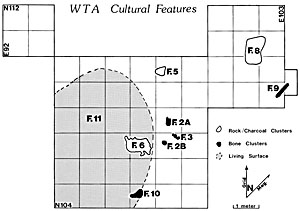
Plan map of the main excavation area and its archeological features (F.#). The
clusters of rock and charcoal are obvious cooking facilities – small pit hearths (e.g., Feature 5)
and somewhat larger clusters (such as Feature 6) where small earth ovens and other cooking
arrangements were likely built. The bone clusters (such as Feature 10) are thought to be purposeful
deposits of fragmented bones placed in simple holes or in small erosional gulleys. Black 1986: Figure 28. Enlarge to learn more and see details. 
|
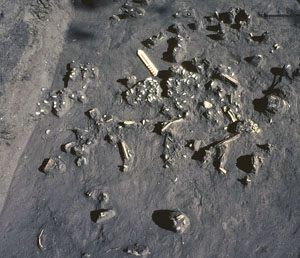
View of Feature 7, which was interpreted as part of a “living
surface” or area of concentrated debris resulting from various camp activities including
butchering, eating, and tool making. Enlarge to see the full image and a close up shot, and
learn more about the clusters of land snails.  |
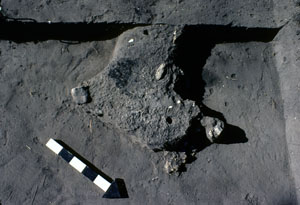
This small pit hearth (Feature 5) filled with ash and charcoal
measured about 18” across and 6” deep, about the size of a small hearth built inside
a hut to keep people warm and cook a small meal. Although no direct evidence of a
structure was detected, the area containing Feature 5 was relatively free of debris,
a pattern that would be expected inside a dwelling. See larger image with
cross-section view and learn more.  |
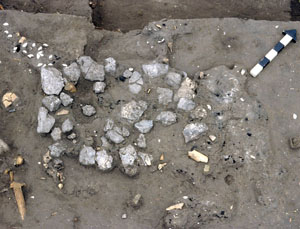
Upon
close inspection this complex pattern of cooking stones, charcoal, ash, animal bones,
and snails was the scene of multiple cooking episodes probably including baking in
small earth ovens as well as stone boiling. Learn and
see more.  |
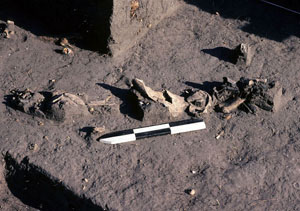
This linear concentration of animal bone (Feature 9) is thought
to represent a purposeful disposal episode – perhaps a narrow erosional gully filled with discarded bone fragments left over from butchering and cooking. Most of
the bones were broken while fresh and/or have cut marks – obvious signs of butchering
– and some of the bones are burned. Black 1986: Figure 19. See larger views and details. 
|
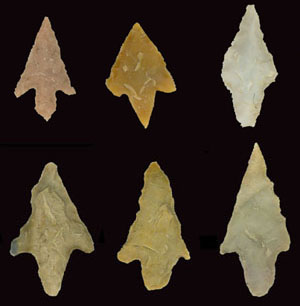
The Perdiz arrow point is the quintessential Toyah artifact. These thin, lightweight points average less than 1” long, but were carefully shaped into sharp triangular blades with pointed contracting stems.  |
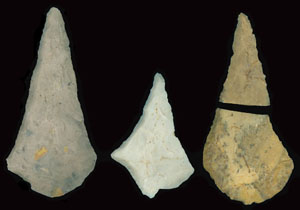
Beveled knives are butchering and skinning tools that started out tool life as large, thin, symmetrical bifaces with wide blades. Throughout their “use life” the knives were repeatedly resharpened by removing small retouch flakes from one direction along one blade edge and from the opposite direction on the other blade edge. This “patterned maintenance” gave the tool it’s distinctive “beveled” appearance (and name).  |
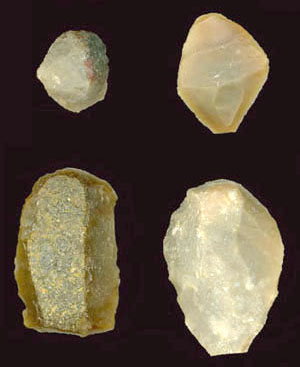
End or hide scrapers were used to render animal hides into useable leather by removing the fat and gunk adhering to the inside of fresh skins. These unifacial tools aren’t unique to Toyah culture, but they are always found at Toyah sites.  |
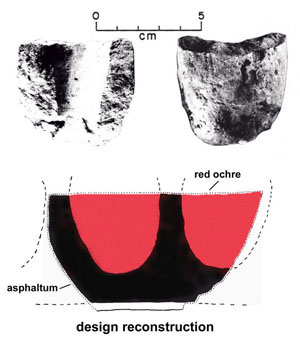
A large fragment of a tubular smoking pipe made of sandstone and
decorated with black asphaltum and red ocher. The reconstructed geometric design consists of four red ovals outlined by wide black (asphaltum) dividers. Stone smoking
pipes have been found at other sites in the region, but there are very few other examples of painted pipes. Adapted from Black 1986: Figure 9. Learn more. 
|
|
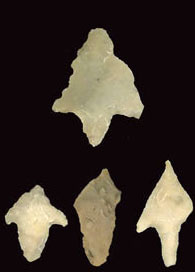
The large sample of about 100 recognizable Perdiz arrow points shows the considerable range of variation in size, stem shape, manufacturing method, and degree of resharpening.
See all specimens.  |
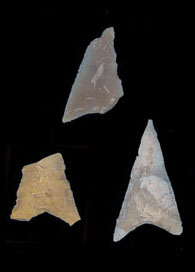
Three triangular arrow points resemble the Starr and McGloin arrow point styles, both more typically found along the lower Texas coast.
See all specimens.  |
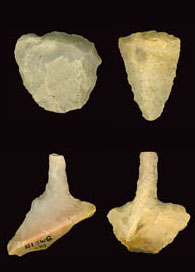
Olmos bifaces (top) and "perforators" or flake drills. The Olmos biface is unique to south Texas and is now thought to represent a small adze form used for woodworking. Flake drills are typical components of the Toyah tool kit. See all specimens.  |
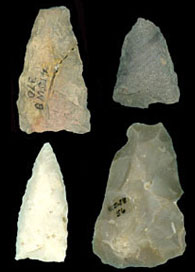
A few larger triangular bifaces were found whch could represent traces of earlier minor occupations of the area or may merely be Archaic artifacts picked up and reused by Toyah peoples. See all specimens.  |
|
Modified Bones and Shells
Animal bones, marine shells, and freshwater clam shells were fashioned into tools and ornaments.
Four deer ulna (fore-arm bone) tools were recovered, three with blunt tips that appear to be
flintknapping tools and one with a pointed and polished tip that is likely a basketry weaving tool.
A bone needle fragment may be a sewing tool. Polished bone beads were made from the leg bones of
large birds (turkeys or cranes, perhaps). The freshwater and marine shell fragments mainly seem to
be ornaments such as beads and pendants and debris leftover from ornament-making. Although the marine
shells fragments were not numerous they are one of several indications of coastal connections, which
is not surprising since the coast is only a two-day walk away.
Ceramics
Bone-tempered earthenware pottery is also one of the hallmarks of Toyah culture. Over 700 pottery
sherds were found at Hinojosa, but most were tiny fragments less than an inch across. Apart from
several fragments of a ceramic pipe bowl and one piece of a figurine, all of the sherds are pieces of
utilitarian pottery including water jars (ollas), bowls, and cylindrical jars. Interestingly, as
much as a quarter of the pottery was decorated with either a red ocher wash (“fugitive red”) or
asphaltum, although the latter may have also been used to mend cracks. Although sharing some traits
(such as the asphaltum) with the coastal pottery known as Rockport ware, the Hinojosa ceramics are
part of the bone-tempered pottery tradition shared by all Toyah sites.
The small figurine fragment is noteworthy. This thumb or cigar-shaped cylindrical fragment is
smoothed and has tiny punctuates (holes) in the finished end. Ceramic figurines are rare in the
region, but known from occasional finds in the Coastal Bend area.
Learn more by reading the report's ceramics section . .
|
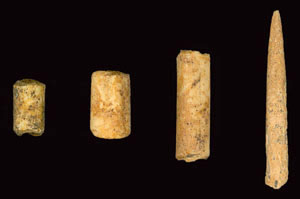
Bird bone beads and the tip of a bone needle, probably used as a sewing tool.  |
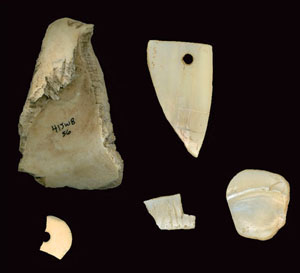
Marine and freshwater shell fragments mainly seem to be ornaments and debris leftover from ornament-making. The largest piece is part of a conch shell tool, an artifact category rarely found at inland sites. The marine shell fragments are one of several indications of coastal connections, which
is not surprising since the coast is only a two-day walk away.  |
|
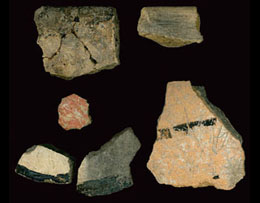
Over 700 pottery sherds were found at Hinojosa, fragments of utilitarian pottery including water jars (ollas), bowls, and cylindrical jars. These are part of the Toyah bone-tempered pottery tradition, although asphaltum from the coast was used to decorate and mend cracks on a few vessels. Learn more.  |
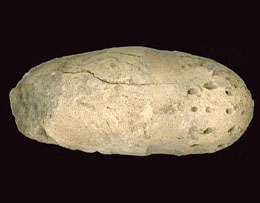
This small thumb- or cigar-shaped cylindrical fragment is part of a ceramic figurine. Such artifacts are rare in the region, but known from occasional finds in the Coastal Bend area.
Learn more.  |
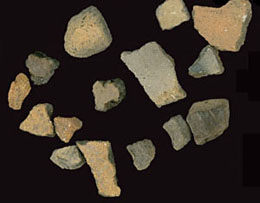
This group of sherds from a single unit-level are typical of the pottery found at Hinjosa. Most of the 700 pottery sherds from the site are tiny fragments less than an inch across.
Learn more.  |
|
Animal Bones
The abundant “faunal evidence” – animal bones – sets the Hinojosa site apart from most
prehistoric sites in the South Texas Plains. The faunal assemblage is one of the largest
and best preserved collections from any archeological site in the region. These bones represent
an incredible diversity of species and habitats – fishes, birds, amphibians, reptiles and mammals.
Of these, mammals are by far the most common. Forty-five taxonomic groups (taxa) representing at
least 31 different species were documented. This diverse array of animals shows that four
ecological habitats were used: aquatic, well-drained prairie grassland, poorly drained grassland,
and woodlands.
Two zooarcheologists (the specialists who study animal bones from archeological sites) studied
the Hinojosa materials. Billy Davidson of Austin identified the bones from the 1975 work and Dr.
D. Gentry Steele from Texas A&M identified those from the 1981 season. Learn more by studying the
list of the identified faunal remains  from the site report. from the site report.
Here are a few of the big findings from the bones. The two most numerous groups of animals were
hoofed animals (artiodactyls) and rabbits (lagomorphs). White-tailed deer were by far the most
common bones, making it clear that this was the main prey. The bones of two other large
artiodactyls, pronghorn antelopes and bison, were also fairly common, but were much less so than
deer. All three of these species were well known from other Late Prehistoric sites in the region.
More surprising was the finding of a fragment of the jawbone of a collared peccary (javelina), a
species that some authorities believed had only entered the region during historic times. The
peccary jawbone at Hinojosa was part of a very tight discard cluster of butchered animal bones,
leaving no doubt that the species was present and hunted in the area at least 600 years ago.
While the hoofed animals provided the lion’s share of the meat, two species of rabbits were also
common – black-tailed jackrabbits and desert cottontails as well as many even smaller mammals such
as rats, voles and ground squirrels. The collective dietary importance of these creatures along
with several kinds of snakes, turtles, frogs, birds, and fish may have been as important as the
larger mammals, especially because these smaller animals could have been trapped, gathered,
or hunted by children and women near to the camp. Big game hunting success is usually hard to
predict, whereas small creatures are more numerous and easier to encounter.
The most common creature is actually the Rabdotus land snail, an
invertebrate about the size of a thimble or a grape. Archeologists have debated whether snails
were eaten by people or just attracted by camp debris, but the latter possibility has been laid to
rest by several careful studies. Land snails were obviously a common food item as they occur by
the hundreds and thousands in direct association with camping debris at many prehistoric sites.
In fact, in unexplored areas of the South Texas Plains, the first clue that archeologists often
have that an archeological site exists are visible concentrations of snails – white specks stand
out on exposed ground.
Based on the excavated sample and known site area, the Hinojosa site is estimated to have
contained well over 200,000 snails. And most were large adult specimens, not the mix of juvenile
and adult snails that would be expected in a natural population. They were found scattered within
the general debris, as dense patches, and in small, tight clusters. The small clusters could
represent the discarded contents of individual containers (such as a gourd or earthenware bowl)
of snail soup. Heat is necessary to release the small invertebrates (the snails) from their
protective shells and it is reasonable to suggest that snails were components of soup or stews.
The large numbers are somewhat deceptive, as takes many snails to amount to much food and snails
rank as only a relatively minor food source.
Mussel shells (freshwater clam shells) were also found at the site in moderately large numbers,
but never as dense accumulations. The clams are edible, but would have been a minor supplemental
food source. Several ornaments (pendants) were found at Hinojosa that were fashioned from mussel
shells. But the most important aspect of the site’s mussel shells is what they say about
Chiltipin Creek. Several different species were present and these have very particular habitats.
Harold Murray of Trinity University in San Antonio identified the mussels and reasoned that
Chiltipin Creek had been a constantly running shallow stream, that possibly flowed from an artesian
source (spring-fed) and had a muddy or muddy sand bottom.
Plant Remains
Plant remains are rarely preserved at open campsites, but many charred plant fragments were
recovered at Hinojosa. Most of those that were recovered were pieces of wood charcoal representing fuel used for cooking and
warmth fires. These generally small chunks were mainly spotted in the ground during the excavations and
saved for identification and dating. Charcoal was concentrated in the cooking features (“rock/charcoal
clusters”).
In addition, there were also a few charred seeds from edible plants recovered from feature “matrix”
(fine sediment) samples and two sets of soil samples collected as columns. Two dozen 2-liter
(1.8 quart) matrix and soil samples were processed using an experimental water separation (flotation)
system at the CAR laboratory. Unfortunately, the results suffered from inexperience and inadequate
analysis time. In hindsight, a more rigorous program of soil sampling and flotation would have almost
certainly yielded more charred plant remains, especially seeds and perhaps nut and root fragments.
The plant remains were identified under the microscope – wood charcoal pieces are snapped to
examine the growth rings and morphological patterns, which are distinctive for certain species.
The wood charcoal and the charred seeds are identified by comparison to modern samples of known
species. The “macrobotantical” work was done by Richard Holloway at Texas A&M.
The many wood charcoal fragments that were identified were overwhelming dominated by fragments of
mesquite and acacia. Small fragments of these related trees are very difficult to tell apart and both
are common in the region and local area. Some fragments were definitely mesquite and it is likely
that this was the dominate fuel type. Other fuel woods identified in smaller numbers were hackberry
and persimmon.
The charred seeds identified that are likely part of the diet were persimmon and chenopodium
(goosefoot) and possibly sunflower. Chenopodium and sunflower have starchy seeds and both plants
were domesticated in the Eastern Woodlands beginning as early as 1500 B.C. But the seeds from
Hinojosa are probably from wild species. Persimmon fruit ripens in the fall and is tart, but edible.
These three plants doubtlessly represent only a tiny fraction of the plants that were gathered and
used for food and medicinal purposes and it is indeed regrettable that a more thorough job of searching
for charred edible plant fragments was not accomplished.
Radiocarbon Dating
The large samples of well-preserved wood charcoal were ideal for radiocarbon dating. The
conventional radiocarbon dating method used for the Hinojosa samples requires relatively large
samples, which were obtained from four different features. Twelve samples were assayed.
Unfortunately, the radiocarbon dating of the site was beset by problems, including laboratory
processing errors and inconsistent results from split samples that should have yielded identical
results.
One assay was rejected because of a processing error. Of the remaining 11 assays, 7 overlap
between A.D. 1350-1400, which falls squarely within the time frame expected on the basis of the site’s
many Toyah artifacts. The four other assays, including two that had paired samples dating to the
expected time range, dated 300-700 years earlier. Although it is possible that these early dates
reflect an otherwise undetected earlier period of site use, this is considered unlikely. Three of
the early dates came from Feature 6, a very well preserved cooking facility, but the same feature
yielded two dates that fall in the expected range. The likelihood that this cooking facility was
used on two separate occasions 300-700 years apart is considered remote.
In the end, the radiocarbon dating problems were never fully resolved. These problems are carefully
discussed in the report's radiocarbon assays section. In hindsight, it is unfortunate
that the modern AMS radiocarbon dating technique was not widely available at the time the work was
done. This technique allows a small, wood charcoal fragment of an identified species (or even tiny charred seeds)
to be dated and has become the dating method of choice in archeology. section. In hindsight, it is unfortunate
that the modern AMS radiocarbon dating technique was not widely available at the time the work was
done. This technique allows a small, wood charcoal fragment of an identified species (or even tiny charred seeds)
to be dated and has become the dating method of choice in archeology.
Other Special Studies: Phytoliths and Soils Chemistry
Two special studies were undertaken that may be of interest to students of archeology. One was an
analysis of phytoliths, durable microscopic biosilica “copies” of plant cells that are formed by
silica absorbed from groundwater. Opal phytoliths, as they are often called, have distinctive
three-dimensional shapes unique to some plant species and families. They are extracted from soil
samples using a laborious chemical separation process. This promising, but challenging line of
research allows skilled analysts to reconstruct past environmental conditions. It has been
successfully developed and applied in some parts of the world. Unfortunately, the pioneering
research done in the 1980s in southern Texas by Ralph Robinson, then a graduate student at Texas A&M, has not
yet been followed by other researchers. Robinson’s preliminary study of samples from the
Hinojosa site was one of only several analyses that he completed before leaving the discipline.
Thus, the results of the Hinojosa study are promising, but must be
regarded as provisional.
The Hinojosa phytoliths included several different types of grasses including tall grasses, short
grasses, and, most intriguingly, several genera of the Pooideae subfamily of grasses. Pooideae
grasses are cool season grasses that thrive in relatively moist conditions. They are present in the
region today, but are relatively uncommon. The presence of numerous Pooideae phytoliths in soil samples
from the Toyah occupation zone at the Hinojosa site was interpreted as indicating that the prevailing
climate was somewhat wetter and possibly cooler than today. To learn more, read the report’s
phytolith study  . .
An experimental soils chemistry study was done of phosphate levels within and outside the
intensively occupied area at the Hinojosa site. This work was done by Black as part of a two-semester
graduate class in archaeometry taught at UTSA by a retired chemist, Donald R. Lewis. Archaeometry is
the application of hard science techniques to archeological materials. Under Lewis’ supervision,
Black analyzed the phosphate levels of soil samples from the site that were systematically collected
within and outside of archeological features. Phosphate levels have long been known to be influenced
by and often concentrated by human activities such as the accumulation of organic wastes as might be
expected from plant and animal processing. The provisional results indicated that several of the
cooking hearths at the site had very localized, very high concentrations of phosphate. Like the
phytolith study, the results of the soils chemistry study were intriguing, but were followed by
little additional research in the region. To learn more, read the report’s soils chemistry study  . .
|
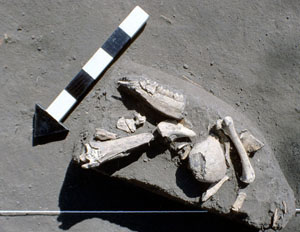
Feature 3, a small, compact cluster of fragmented
animal bone. This small grouping contains bones from at least seven different animals including deer,
bison, jackrabbit, tortoise (land turtle), wood rat, turtle, and a mole. The mix of large and small
animals from different habits is typical of the overall faunal assemblage.  |
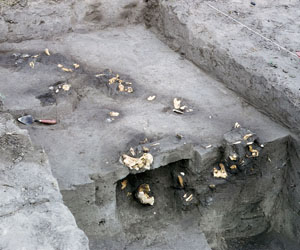
The 1975 testing encountered this concentrated deposit of
butchered and broken animal bones, dubbed the “bone bed.” The largest fragments are bison bones, but the bones of deer and smaller animals were also present. Unfortunately, when
archeologists returned to the spot in 1981 to further expose the area they encountered
a very large complex of leaf-cutter ants, perhaps drawn to the softened deposits
created by the back-filled test pits. The bone bed probably represents a convenient
erosional gully where Late Prehistoric peoples disposed of bones and other debris.
Note the dark organic-stained fill of the apparent gully. Smaller, but similar
clusters of bone were documented elsewhere at the site in 1981. Photo by Tom Hester.  |
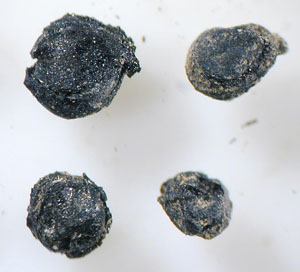
Tiny charred seeds similar to these recovered from several different contexts within the Hinojosa deposits were identified as goosefoot (Chenopodium berlandieri). Both the protein-rich leaves and starchy seeds of goosefoot are known to have been consumed by Indian groups in the American Southwest and Northern Mexico. Goosefoot must have been one of many different plants that were part of the diet of those who camped at the Hinojosa site, but plant remains are rarely preserved. Photo by Phil Dering.  |
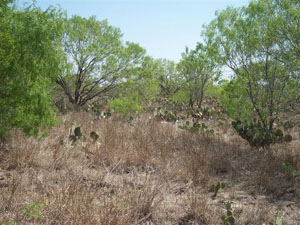
Honey Mesquite is a characteristic tree species of the South Texas Plains. Mesquite and Acacia wood were the main firewood identified at the Hinojosa site. The charred fragments of both species are hard to distinguish, but both trees are common in the site area today. Photo by David Calame.  |
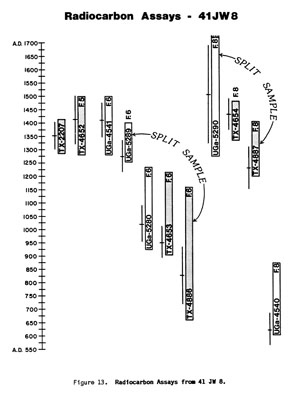
Radiocarbon assays from Hinojosa overlap most strongly between A.D. 1350-1400, the inferred main period of occupation. There were, however, unresolved dating problems, as discussed in the text. From Black 1986: Figure 13.  |
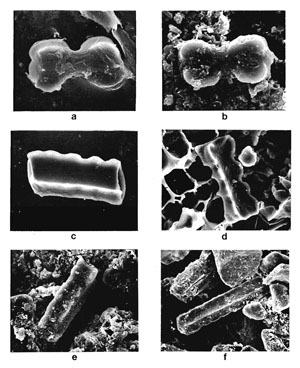
Phyotoliths extracted from soil samples from the site (b, e, and f) and from modern comparative collections (a, c, and d). Plants produce distinct types of these tiny cells. The Hinojosa phytoliths included tall grasses, short grasses, and, most intriguingly, several genera of the Pooideae subfamily of grasses. Pooideae grasses are cool season grasses that thrive in relatively moist conditions. Their presence suggests that the prevailing climate was somewhat wetter and possibly cooler than today. Black 1986:Fig 16. More. 
|
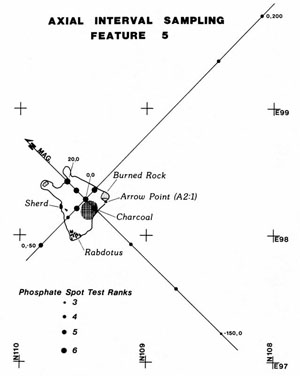
Special soil samples were collected from Feature 5 for phosphate analysis. This experimental "axial interval" sampling technique revealed a markedly higher concentration of phosphate within the small pit hearth, indicating concentrated organic waste. Black 12986: Figure 15.  |
|
| |